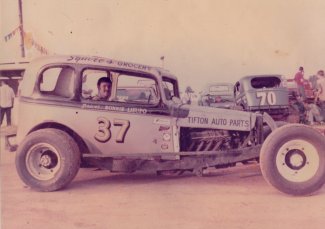
Ronnie Lieupo sits in his father’s 1935 Chevrolet powered by Ford at the Thunderbowl Speedway.
By Mike Bell
Posted in Feature Stories 3/16/12
Whenever you ask someone about Ronnie Lieupo, they immediately start smiling and remember a joke he told them or pulled on some unsuspecting racer. But don’t think Ronnie isn’t a serious racer. Once he got to drive he would be up front with any of the great drivers in South Georgia or North Florida. We say “once” because Ronnie has been around racing since he was born.
Ronnie remembered when he got directly involved in racing.
“When I was about 8 or 9, they would get me to wash the inside of the sedan that Sam (McQuagg) drove for Laverne (Kendrick),” he said. “He always wanted to go to the track first class and a completely clean car was apart of that.”
The 1934 Ford sedan was gold on the outside but was painted white on the inside.
“You had to get inside and get completely soaked to get all that red clay from last week’s racing,” Ronnie added.
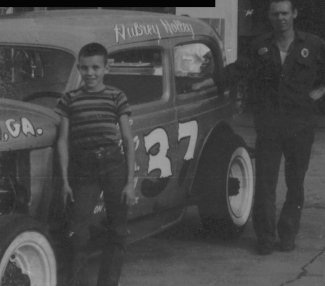
A 10-year-old Ronnie stands at the front of the 1937 Plymouth sedan that Bill Childers and his father, Johnny drove up to Milledgeville to purchase. They drove the car back to Tifton.
“I was born June 15, 1949 in Valdosta, GA, and attended my first race before I knew what a race was,” Ronnie said. “My mother (Betty) would go through the pit gate with me in her arms. When she parked the car at Jacksonville Speedway on Lane Avenue, she would let my dad (Johnny) and my uncle out of the trunk. I suppose money was scarce in 1950.”
Ronnie had a younger sister, Margaret Ann, who was 18 months younger than him, but she died at age 44 from heart complications. They had operated on her heart when she was very young. She had married fellow racer Andy Squires and had three daughters.
Ronnie remembers his father, “He followed construction work (building roads and highways) from Baltimore to Miami the next ten years and I saw a lot of race tracks. At the age of eleven my dad bought a Texaco service station in Tifton, GA. We set down roots. I graduated from the local high school in 1967 and attended 1-½ years at ABAC (Abraham-Baldwin Agricultural College) until entering the Guard. Once out of the military training I never went back which I regret.
“Going to the Thunderbowl Speedway on Saturday night was a regular occasion. Laverne Kendrick, a local race car owner, would bring his yellow 90X to our station weekly for me to wash. It was a ’34 Ford coupe and Sam McQuagg drove it for him.”
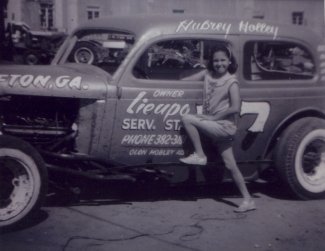
Ronnie’s sister Margaret Ann stands next to the Plymouth sedan that Aubrey Holley drove for Johnny Lieupo.
“The following year, Laverne built a ’34 Ford sedan, the original gold 90, and I continued to wash it also,” Ronnie continued. “Being as I was eleven years old and small, they felt I did a really good job on the inside. We have a photo of this car in front of our service station. This is also the car that Rex White refers to that Sam (McQuagg) turned over in practice and went on to win the feature at Jacksonville.
“The following year, my dad and Bill Childers went to Milledgeville, GA, bought a ’37 Plymouth sedan, drove it back to Tifton and built a race car out of it. This ’37 Plymouth was about ¾ finished along this time when Aubrey Holley told us he would help finish the car if he could drive it. He had just moved down from Griffin where he had done some driving. This started a string of drivers for my dad including Jay Pannell, Jimmy Capps, Coot Rowland, Yankee Smith, myself and Louie Radney.”
“At that time, Hawkinsville would have a race every other Sunday,” Ronnie said. “So some of the drivers would race at Valdosta on Saturday night and spend the night in Tifton. Before heading out for Hawkinsville, they would gather up at my dad’s service station. It could not have been better for me being able to be in the midst of race drivers because that is what I wanted to be.
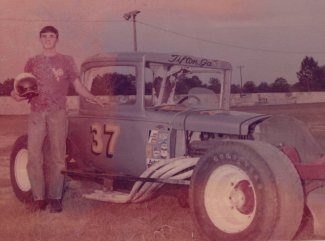
This is the Model A coupe that Ronnie and his father had finished for 2 years before they ran the car. Ronnie’s mother Betty Lieupo didn’t want Ronnie to drive and he was so young that he had to have her permission before the tracks would let him drive. This was taken in 1968 when the Thunderbowl reopened for sportsman racing.
“I-75 Speedway opened in ’63 and became a NASCAR track. This meant I could not go into the pits. So I bought a NASCAR license for $35 and I had to show it many times. After I-75 Speedway closed in ’67, a few races were run independently. We won the last two races ever run in ’69 ahead of Louie Radney, Jr.
“Franklin Quick Change rear ends in Ruskin, FL, would pay you $41 for a complete ¾ ton Ford or Studebaker rear end assembly. We gathered up enough to swap for a quick change rear, four aluminum hubs, brakes and a drive shaft. In those days a workingman could have a race car if he played all the angles.”
“There were a lot of tricks to the trade that came easy,” Ronnie continued. “Being friends with Eddie and Aubrey and watching Sam, Willie McDonald, Harvey, Curtis Morgan and others, I learned a lot and not the hard way. By the time I was 14 years old, I could arc weld, acyelene weld and fabricate. In 1965, you better know how to make something you needed because you could buy very little. We went to the junkyard, found something that was close, then made it work. Learning frame and bodywork seemed to come in handy too. Bill Childers taught me bodywork. Talmadge Dean taught me frame work. I’ve been doing the trade 42 years.
“When I was fifteen, we built a Model ‘A’ coupe, shortened and narrowed. This car sat race ready lacking an engine for two years. My dad knew I wanted to drive it and he knew my mama wasn’t going to have it. I took a job at a fast food establishment on the weekends thinking it would make me not to think about racing. Two years later it still did not work. One Saturday night at the Thunderbowl, Roy Graham wrecked his car and announced it was for sale. I rustled up my dad and we made a deal and bought the car.
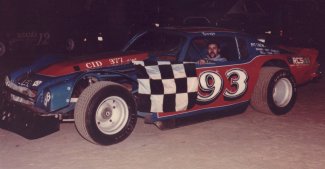
You can tell from the super clean lines that this is a Tommy Riggins built car. Danny Clanton owned the car.
“We didn’t know the engine in the car wasn’t legal but I didn’t care. We kept the engine and sold the rest of the car for what we paid for it. After finishing sixth and third in the first two races, my dad said we had to build a legal engine. The cubic inch limit was 300. We built a 265 plus .020 over with a 327 crank. This was a stump puller. First night out we out ran Harvey Jones (from Tallahassee, FL) and he protested us. We were legal. Later in years Harvey told me that if you’re getting beat protest and see what they have.”
“The first late model I drove was a ’57 Chevy built by Doc Blanchard,” Ronnie said. “Bud Wilson and Dunbar Hankinson owned it. They blew an engine at the Thunderbowl one Saturday night. The following Thursday, Waycross had a 75 lap race. We took the engine out of my sportsman car and put it in their late model. We finished third to Eddie and Rance. When we split the money, Bud and Dunbar had enough money to fix their engine.
Later in 1969, I drove this same car at Jacksonville, FL. At 19 years old, I was running 6th on lap 165 of a 200 lapper when the suspension broke. Eddie won and Bobby Allison was second. Also there was Tiny Lund, Tom Pistone, Sam Sommers, David Ezell and many more. Tiny Lund wound upside down outside the track on a street by the backstretch.”
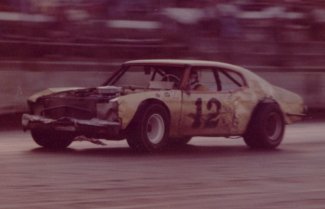
This is a photo of a worn out race car. Even though you may not be able to recognize it but the car was a 1970 Chevelle owned by Rex Etheridge of Valdosta. Ronnie won 22 or 24 features with this car in 3 years. This photo must have been taken during the last year.
“I missed most of the 1970 season due to joining the National Guard,” he continued. “I was in Fort Polk, LA, from March until August. The season ran from April until September. I wanted to win a championship really bad but it was impossible missing a race a month to Guard drills. I got out of the Guard in 1976 and won my first championship in 1977.
“In the early seventies, we still ran the sportsman class and won races at Valdosta, Lake City, Waycross and Brunswick. By the middle seventies, late models had taken over. We (Walter Bazemore, Rex Ethridge, Randy Bright and Bo Blanton) built a ’70 Chevelle with an open chambered big block. Boy I loved those 427’s. In two years we won 25 features and a track championship at Columbia County Speedway including some track records. After winning the last race of the season, Rance Phillips asked me if we were going to Brunswick the next day. We did and had fast time over 56 late models. Billy Clanton was outside pole. We led it seven laps and broke a piston. This car failed to finish only four times.
“Also when we were driving the skeeter cars and the late models, early in the night my sportsman was scratched. Gary Johnson had a short ’34 Ford that had been built in North Georgia. Gary was just getting started racing so he asked me to drive his car in the heat race. I told him that he needed the seat time but he wanted a picture of his car with the checkered flag. The car was pretty and fast. He had a steering wheel on the car that was real small. I asked for a bigger wheel and he had one. I got him the picture.”
“At the last race of the 1972 season, Sputter Ragan drove Wade Murphy’s car in the feature because his primary car was scratched,” Ronnie said. “This was the first time Sputter had driven the car and it was fast. Sputter drove the car #64 to the top three when he got tied up in a wreck and turned it over. Wade asked me to help him fix it in the off-season. So I did and drove it. Opening night the next season I don’t know who had pole and outside pole but Louie Radney was inside second row in his famed red #83 and I was outside in a field of at 20 cars. When the green flag came out both of us wanted the sweet spot in the grove. We went by the flag stand backwards. After the caution, we got our places back. At the restart, Louie and I did the same thing. After that we went to the rear. Late in the race both of us had made it back towards the front when I got tangled with the same car Sputter did the year before and turned Wade’s car over again. ‘Irony’: First time Sputter and I drove the car each one of us turned the car over.
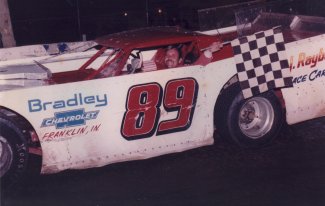
Ronnie with the checkered flag in Jon McGee’s car from Thomasville, GA. Ronnie drove the car twice and won twice in 1985.
“Early in my life I’d heard about race track superstitions. There was the number 13, color green, peanuts, full moon and probably others. In 1972 I towed my car to a National Guard drill. I forgot to bring extra clothes so when I went to the track I drove in my fatigues and wound up winning. Green didn’t bother me after that. Another competitor told me you get the green to start the race, and then you get the green when it’s over.”
Another superstition story was from racing in Lake City.
“We had towed the Chevelle to Columbia County for a Friday night show,” Ronnie told us. “Competition was real stiff on this half-mile. The first nine races of the year had nine different winners. It was Friday the 13th with a full moon and I drew the pill number 13. I told my car owner, Rex Ethridge, we should load up and go home. But we stayed. I told Rex some one was going to win and it might as well be us. So we became the first repeat winner of the season. I forgot about superstitions.
“After the season ended in Middle and North Georgia, some of those guys (Leon Archer, Doug Kennimer, Roscoe Smith, Dick Mills and others) would come down to race. Some were here on a July 4th Bicentennial race for 76 cars. We won the race with that ’70 Chevelle with Leon Archer second.
“Then I drove a car wrenched by Jon McGee. One night after a protest we had to move the engine forward to meet the specs. This fixed a push the car had and we set a track record at Columbia County that was held for two years.”
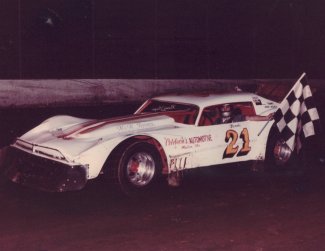
Ronnie in James Coleburn’s (Madison, FL) Jig-A-Lo Corvette with coil springs under it. He set the track record at Lake City with the car as well as win 6 to 8 features in 1979.
“In 1979, I started to drive for James Coleburn of Madison, FL. He had a Chevy Nova that Tommy Riggins had built,” Ronnie said. “A few races later, James bought a Jig-A-Lo Chassis with a Corvette body. We won some races with it and broke a track record at the Lake City short track (now North Florida Raceway). James then bought a coil over Jig-A-Lo (Firebird). We won 22 features that year with a couple more track records. James wanted to cut my percentage so we parted company but remained friends.
“Then I drove for Danny Clanton, Mike Bostic, Henry Steedley, Jon McGee, Larry Walker, Ben Sumner and some more.
“We took Danny Clanton’s car to Cochran. Nasworthy had won all the races that year. We had a short rod 406 with a hub. Never racing there before we guessed at tires and the gear. We qualified outside pole, won the race to the corner and left. Sometimes things turn out right.
“Another time Danny called when my arm was in a cast – elbow down. He wanted me to qualify his car on Friday night. His driver (Marlin Huffmaster) couldn’t be there until Saturday. So I went out and had fast time in his C. J. Rayburn that I had yet to drive, cast and all.
“I tried some asphalt around 1990 but didn’t care for it. Those guys got mad when I put zeroes on their doors.”
“By 1992, I was driving for Bobby Stracner,” Ronnie said. “He had bought a Walter Newman chassis. We won a few Saturday night events and ran second to Tuck Treadham in a 100-lapper. That off-season, we built a Twister Chassis at John King’s. In two years we won 18 features including two 50-lap races. We finished second two more times to Tuck in 100-lap events. We took the championship at the Thunderbowl and the Bearden Oil Championship that last year.

Ronnie Lieupo (182) leads Lavon Sloan in the #22 with Jimmy Murphy in the Cooper Brothers #68 out of the fourth turn at the Thunderbowl.
“By now my son wanted to race. It was 1996. We raced three years and he won 26 features. The cost got to us.
“I raced off and on until 2000 except for a vintage race at Douglas, GA, in 2007. I drove a ’34 Ford sedan with a 383 stroker. As luck would have it I drew on the pole, won my heat and the feature. Anybody that had more fun than the people I raced with and against just had more money.”
“It was late in my 32 years of racing that I appreciated seeing my friends every weekend,” said Ronnie. “Some of them are gone but I’ll never forget them – J. T. Gordon – Marlin Huffmaster – Harvey Jones – Sam McQuagg – Aubrey Holley – Jon Thorne.
“I drove over 50 different race cars on 16 different tracks in my career. A lot had the same number but they were totally different cars. Some were Car House, Walter Newman, Custom Chassis, Jig-A-Lo, Barry Wright, Master Built, Russell Brown, Twister, Howe, Tommy Riggins and homemade. I didn’t get to race long with my heroes because they were a good bit older than me. I did have a lot of fun with Rance Phillips, Harvey Jones, Dickey Ferry, Louie Radney, Sputter Ragan, Bill O’Neal, Marlin Huffmaster, Steve Moran, Jimmy Murphy, Lavon Sloan, J. T. Gordon, Larry Benton Wayne Suggart and too many more to mention.
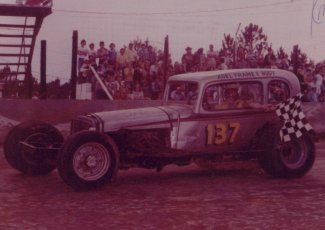
This is the last car Ronnie built – a 100-inch wheelbase sportsman that he ran at the Thunderbowl with some success.
“Along with building and fabbing cars, I built most of the engines we raced. The only part of the engine I didn’t do was the machine work. Locally I had Jack Patrick, James Watson, Buster Christie, Mack Shiver or Joe Walker, all of which I am still friends with today. The only owner I didn’t mess with the engine much was Jon McGee. He might be a little short on handling but he was seldom short on horsepower. Everybody buys HP today. That makes it impersonal to me.”
“In 1980, we had won 4 races in a row at Waycross when a man asked me whose engines did we run,” he told us. “I said they are ours. He said ‘I know but who do you but them from.’ I said we build them. We built the short block, I degreed the cam, and then came Dennis Clements heads and intake. The cam was a Reed and you could move it around. If the car were a little loose off the corner I would back the cam up a little. The quicker you got the throttle down the faster the lap times were. Lap times were most important.

This is one of the last open wheel cars Ronnie drove. It was originally a North Georgia car.
“After 32 years, I have 27 large trophies. That’s a lot considering few were given out and the car owner got a lot of them. I should have gotten duplicates but when you are young you think about the next race, not the last one. I didn’t drive after winning the vintage race in 2007. To me, I went out a winner. Not many things were as satisfying as driving a good fast racer and winning the race. That solidified that you were the best for that night, week or until the next race was run. Driving was natural for me; it could not be learned. You could get better at it. If you thought about doing something in a race car, you better have already done it. At any given race you could score many times. Quick time, track record, match race heat race, consi or feature. In the middle seventies, some of us drove 2 classes – sportsman and late models. I guess that was twice as much fun. We were pretty much in one car or the other all night.”
After all those years in racing Ronnie found time to join the Elks Lodge and the American Legion. He has also been elected to the City Council of Dasher, GA and reelected twice. Ronnie and his wife Debra enjoy life in the small town with their children and grandchildren living nearby.
“To all my friends, family and competitors….I loved most of you!”
Editor’s note: This story originally appeared in the June 2010 edition of the Pioneer Pages magazine.
Mike Bell is a Georgia racing historian and volunteer for the Georgia Racing Hall of Fame.
Questions, comments, suggestions? Email us!
This website is not affiliated with or endorsed by the Georgia Racing Hall of Fame or the Georgia Auto Racing Hall of Fame Association, Inc. All content is the intellectual property of the individual authors. All opinions are those of the individual authors. Please do not repost images or text without permission.
